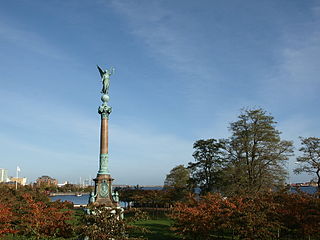
The national flag of Denmark is red with a white Nordic cross, which means that the cross extends to the edges of the flag and the vertical part of the cross is shifted to the hoist side.

The Order of the Dannebrog is a Danish order of chivalry instituted in 1671 by Christian V. Until 1808, membership in the Order was limited to fifty members of noble or royal rank, who formed a single class known as White Knights to distinguish them from the Blue Knights who were members of the Order of the Elephant. In 1808, the Order was reformed and divided into four classes. The statute of the Order was amended in 1951 by a Royal Ordinance so that both men and women could be members of the Order. Today, the Order of the Dannebrog is a means of honouring and rewarding the faithful servants of the modern Danish state for meritorious civil or military service, for a particular contribution to the arts, sciences or business life, or for working for Danish interests.

His Danish Majesty's Yacht Dannebrog (A540) was launched by Queen Alexandrine at Copenhagen in 1931, and commissioned on 26 May 1932. The yacht now serves as the official and private residence for King Frederik X, and members of the Royal Family when they are on official visits overseas and on summer cruises in Danish waters. When at sea, the Royal Yacht also participates in surveillance and sea-rescue services.

The Battle of Køge Bay (1710) also referred to as the Second Battle of Køge Bay, was an indecisive battle that took place on 4 October 1710, during the Great Northern War, in Køge Bay, just south of Copenhagen. Denmark had 26 ships of the line and 5 frigates with 1808 guns, and Sweden had 21 ships of the line and several frigates with 1512 guns. The Danish ship Dannebroge exploded and of the 550-man crew only 9 survived. The Swedish ships Tre Kronor and Prinsessan Ulrika Eleonora ran aground. Because of the weather the battle could not continue. However, the Swedish fleet managed to sink and capture a Danish convoy of transport ships that were supposed to embark a Russian invasion force in Danzig. The action in Køge Bugt checked those Russian invasion plans of Sweden.
USS Percival may refer to the following ships of the United States Navy:

The history of the Danish navy began with the founding of a joint Dano-Norwegian navy on 10 August 1510, when King John appointed his vassal Henrik Krummedige to become "chief captain and head of all our captains, men and servants whom we now have appointed and ordered to be at sea".

Iver Huitfeldt was a Danish-Norwegian naval officer who was killed in action, when he commanded the ship Dannebroge during the Great Northern War 1700–1721.
PS Ruby is the name of several ships:

The Danish ironclad Dannebrog was an armored frigate of the Royal Danish Navy that was originally built as an 80-gun ship-of-the-line by Andreas Schifter was launched in 1850 but was reconstructed into a steam-powered ironclad in the early 1860s. She had an uneventful career before the ship was stricken from the navy list in 1875. The ship was converted into an accommodation ship that same year and served until she became a target ship in 1896. Dannebrog was broken up in 1897.

HDMS Dannebroge was a Dano-Norwegian ship-of-the-line that exploded and sank on 4 October 1710, during the Great Northern War. Almost all of its crew of 600 were killed - one third of the victims were Norwegians. Admiral Iver Huitfeldt was among the casualties.

The Ivar Huitfeldt Column is a monument at Langelinie in Copenhagen, Denmark, built to commemorate the death of Admiral Ivar Huitfeldt and his men from HDMS Dannebroge, which exploded and sank in the Battle of Køge Bat during the Great Northern War. The monument was constructed in 1886 to a design by Vilhelm Dahlerup. Ferdinand Edvard Ring was responsible for the statue of the Roman goddess of victory, Victoria, and for the reliefs, while Carl Brummer undertook the monument's architectural design.

Dannebrog was a Danish royal side-wheel paddle steam yacht, which was built in 1879 and decommissioned in 1931. Dannebrog was named in honor of the flag of Denmark.
Two Danish royal yachts have borne the name Dannebrog:

Orlogsværftet was a Danish naval shipyard under the Royal Danish Navy. Before 1924, it was an integral part of the naval base at Holmen in central Copenhagen, Denmark, with an independent management from 1692 when Olaus Judichær became the first factory director.

Danish-Baltic Auxiliary Corps was a Danish company of military volunteers, established 1919 as a non-governmental initiative to help in the Estonian and Latvian war of independence. It was originally planned to send several companies to help, but due to the success of war, only one company was sent, Compagnie Borgelin. The company consisted of approximately 200 men with Captain Iver de Hemmer Gudme as corps commander and Captain Richard Gustav Borgelin as company commander.
Henrik Span was a naval officer in the Dutch, Venetian and Danish services. He reached the rank of Admiral in the Royal Danish Navy in 1683 and headed the Royal Danish Naval Dockyard in Copenhagen from 1690. In 1692, he was granted Hørbygaard at Holbæk and raised to the peerage by Christian V of Denmark.

Diderich de Thurah (1704–1788) was a military cadet, a naval officer in the Royal Danish-Norwegian navy, shipbuilder and fabrikmester, artist and publisher.
SS John Mitchell may refer to the following ships:
Dannebrog, also spelled Dannebroge, was an East Indiaman of the Danish Asiatic Companym bought in England in 1786. She sailed on eight expeditions to Danish India.
This page is based on this
Wikipedia article Text is available under the
CC BY-SA 4.0 license; additional terms may apply.
Images, videos and audio are available under their respective licenses.












